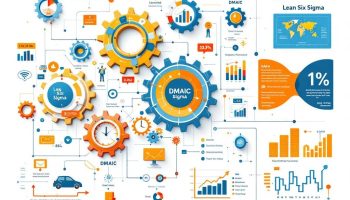
Value Stream Mapping Software: Transforming Workflow Optimization
Value stream mapping software transforms workflow optimization by converting manual mapping into dynamic digital solutions for business workflow visualization and documentation. This powerful technology originated from Toyota’s Lean Production System and helps organizations identify inefficiencies, waste, and bottlenecks through comprehensive digital tools.
Key Takeaways:
- Value stream mapping software provides visual workflow documentation and data-driven analysis capabilities.
- Digital tools enable real-time collaboration and standardized process mapping.
- Automated calculations help track cycle times, lead times, and takt time.
- AI integration is transforming value stream mapping with predictive analytics and intelligent recommendations.
- Implementation can lead to significant operational efficiency improvements across various industries.
Digital value stream mapping offers substantial advantages over traditional paper methods. With specialized software, you’ll create accurate process visualizations while automating key calculations that previously required manual effort. These digital tools maintain the core principles of identifying value-adding activities while eliminating inefficiencies.
Modern mapping platforms support remote team collaboration, allowing simultaneous edits and updates to process documentation. This capability proves essential in today’s distributed work environments where teams need to coordinate improvement efforts across different locations.
The analytics capabilities built into today’s software solutions provide deeper insights than paper-based alternatives. You can track performance metrics in real-time and identify optimization opportunities through data visualization tools. Many platforms integrate with existing business systems to pull accurate operational data directly into your value stream maps.
AI-powered features now enhance many value stream mapping tools, offering predictive analytics and intelligent recommendations for process improvements. These advanced capabilities help identify patterns and optimization opportunities that might go unnoticed with manual analysis methods.
Organizations across manufacturing, healthcare, software development, and service industries report significant efficiency gains after implementing digital value stream mapping. The digital transformation of process documentation creates clearer visibility into operations and supports continuous improvement initiatives throughout the organization.
“Value stream mapping software transforms traditional workflows into dynamic digital solutions, empowering organizations to visualize inefficiencies and optimize operations with powerful, data-driven insights. With AI integration and real-time collaboration, this revolutionary approach not only streamlines processes but also drives significant operational efficiency across industries.”
Defining Value Stream Mapping Software
Value stream mapping software transforms traditional manual mapping processes into streamlined digital solutions for visualizing and documenting your entire business workflows. This powerful value stream mapping software originated from Toyota’s Lean Production System and now supports lean management principles across multiple industries. You’ll find these digital tools essential for identifying inefficiencies, waste, and bottlenecks in your organizational processes.
Core Components of Value Stream Mapping Tools
Value stream mapping software provides a comprehensive framework for process improvement by digitizing what was once a paper-based activity. When implementing value stream mapping software in your organization, you’ll benefit from:
- Visual workflow documentation that captures both material and information flows
- Data-driven analysis to identify non-value-adding activities
- Real-time collaboration features for cross-functional team input
- Standardized process symbols and mapping conventions
- Automated calculations for cycle times, lead times, and takt time
These digital tools significantly enhance your ability to implement continuous improvement initiatives. The value stream mapping software allows you to document current state maps and design optimized future state maps, making it easier to track progress toward efficiency goals.
Value stream mapping software serves as the foundation for effective process optimization methods, helping you eliminate the 80-90% of typical business tasks that are non-value-adding according to PwC studies. Your teams can use these tools to create detailed process visualizations that highlight areas where waste occurs and identify opportunities for streamlining operations.
| Aspect | Traditional VSM | Value Stream Mapping Software |
|---|---|---|
| Creation Time | Days to weeks | Hours to days |
| Collaboration | Limited to physical meetings | Real-time digital collaboration |
| Data Analysis | Manual calculations | Automated metrics and KPIs |
| Scenario Testing | Difficult and time-consuming | Quick what-if analysis capabilities |
| Version Control | Paper-based, difficult to track | Automatic versioning and change history |
By leveraging value stream mapping software, you’ll transform your approach to strategic project management and process improvement, gaining clearer insights into where your resources are being used effectively and where waste can be eliminated.

Strategic Benefits of VSM Software
You’ll gain substantial advantages from incorporating value stream mapping software into your workflow optimization strategy. Research from PwC reveals that 80-90% of typical business tasks are non-value-adding – a startling statistic that highlights the critical need for effective process analysis.
Value stream mapping software provides clear visual representations of all process steps, allowing you to immediately identify wasteful activities. This visibility helps you spot bottlenecks that would otherwise remain hidden in complex operational flows. By mapping your entire value stream digitally, you can make data-driven decisions about where to focus improvement efforts.
Cross-functional collaboration improves dramatically when teams share a common visual understanding of workflows. The software creates a unified platform where departments can communicate effectively about process challenges and solutions. This alignment is crucial for successful project collaboration and organizational change initiatives.
Key Strategic Advantages
Value stream mapping software delivers several competitive advantages that directly impact your bottom line:
- Reduction in lead times through elimination of non-value-adding activities
- Enhanced quality management by identifying error-prone process steps
- Improved resource allocation based on data-driven workflow analysis
- Accelerated digital transformation through process standardization
- Better alignment between operational activities and strategic goals
The right value stream mapping software enables continuous improvement by providing both baseline measurements and ongoing performance tracking. This capability transforms your improvement initiatives from occasional projects into a systematic approach to operational excellence.
When implementing value stream mapping software, you’ll need to focus on stakeholder engagement to ensure broad adoption. The software provides the technical foundation, but successful implementation requires organizational buy-in at all levels.
Value stream mapping software stands out among process improvement tools by combining visualization capabilities with analytical power. Unlike basic flowcharting tools, comprehensive value stream mapping software includes metrics tracking, simulation capabilities, and integration with other business systems.
Implementing value stream mapping can lead to a 30% improvement in operational efficiency in many organizations.
forbes.com
AI and Automation in Value Stream Mapping
Value stream mapping software has evolved significantly with the integration of AI and automation capabilities. You’ll find these technological advancements transforming traditional VSM from static documentation into dynamic management tools that continuously optimize workflows.
Nearly 90% of companies now expect AI to enhance their value stream mapping software capabilities. This shift represents a fundamental change in how organizations visualize, analyze, and improve their processes. AI-powered value stream mapping software collects data automatically, eliminating the manual effort previously required to document each process step.
The integration offers several powerful advantages:
- Automated data collection from multiple systems
- Real-time process monitoring and analysis
- Predictive analytics to forecast potential bottlenecks
- Pattern recognition to identify hidden inefficiencies
- Intelligent recommendations for process improvements
Transforming Process Management Through Technology
Value stream mapping software with AI capabilities connects seamlessly with your existing DevOps pipelines and monitoring solutions. This integration creates a comprehensive view of your entire value stream, from initial customer request to final delivery.
The following table highlights how AI transforms value stream mapping software functionality:
| Traditional VSM | AI-Enhanced Value Stream Mapping Software |
|---|---|
| Static snapshots | Dynamic, real-time process visualization |
| Manual data collection | Automated multi-source data gathering |
| Descriptive analysis | Predictive and prescriptive insights |
| Periodic reviews | Continuous monitoring and alerting |
| Subjective improvement ideas | Data-driven optimization recommendations |
When implementing value stream mapping software with AI capabilities, you should understand the key implementation phases to ensure successful adoption. The technology not only documents your current state but actively suggests optimal future states based on historical data and industry benchmarks.
AI-powered value stream mapping software also helps you address project roadblocks before they impact delivery timelines. By identifying patterns that lead to delays, the software provides early warnings and suggests mitigation strategies.
For organizations pursuing continuous improvement, value stream mapping software with AI capabilities provides the foundation for data-driven decision making and process optimization. You’ll gain unprecedented visibility into how value flows through your organization, enabling targeted improvements where they’ll have the greatest impact.

Industry Applications and Use Cases
Value stream mapping software serves as a powerful tool across multiple sectors, helping organizations visualize workflows and eliminate inefficiencies. You’ll find these digital solutions transforming operations in various industries with specialized applications.
Cross-Industry Implementation Examples
In manufacturing, value stream mapping software helps optimize production processes by identifying bottlenecks in assembly lines. Factory managers use this technology to track material flow, reduce inventory costs, and minimize production delays. The software visualizes each step from raw materials to finished products, highlighting non-value-adding activities that can be eliminated.
Healthcare organizations implement value stream mapping software to enhance patient care journeys. By mapping the complete patient experience from admission to discharge, hospitals can identify unnecessary waiting periods and streamline documentation processes. This leads to improved patient satisfaction and more efficient resource allocation.
Software development teams rely on value stream mapping software to enhance their delivery lifecycles. The tools integrate with existing DevOps pipelines, providing visibility into code development, testing, and deployment stages. You can track work items throughout their lifecycle, identify delays in handoffs between teams, and optimize sprint planning with data-driven insights.
The construction industry leverages value stream mapping software to improve project planning and safety adherence. Project managers can visualize the entire building process, from design approval to final inspection, identifying areas where materials or information get delayed. This helps in accelerating project timelines and reducing costly rework.
Financial services organizations use value stream mapping software to streamline customer onboarding and transaction processing. Banks can visualize application approval workflows, identify redundant compliance checks, and accelerate service delivery while maintaining regulatory requirements.
Retail businesses implement the software to optimize their supply chain operations. By mapping inventory management, order processing, and fulfillment activities, retailers can reduce delivery times and improve customer satisfaction. The value stream mapping software helps in fostering continuous improvement throughout the supply chain.
Each industry application demonstrates how value stream mapping software translates lean principles into digital workflows, enabling teams to collaborate more effectively and focus on value-creating activities. The visual nature of these tools facilitates better communication across departments, making complex processes easier to understand and optimize.

Leading VSM Software Tools
You can transform your workflow efficiency with powerful value stream mapping software tools that deliver real-time insights and process optimization capabilities. Modern VSM solutions help you visualize, analyze, and improve your entire value stream while eliminating waste and bottlenecks.
Top Value Stream Mapping Software Solutions
Several industry-leading platforms provide comprehensive value stream mapping software features to optimize your business processes:
- Atlassian’s Jira Align and Confluence offer robust value stream mapping software capabilities that integrate seamlessly with agile development workflows, allowing you to track value delivery across complex organizations.
- ConnectALL provides specialized value stream mapping software with strong integration options that connect disparate tools and systems into a unified value stream view.
- Tasktop delivers enterprise-grade value stream mapping software with metrics-driven insights that help you measure flow efficiency and identify improvement areas.
- Plutora focuses on value stream management with comprehensive value stream mapping software features for visualizing and optimizing software delivery pipelines.
- Broadcom’s Value Stream Manager combines value stream mapping software functionality with portfolio management to align IT initiatives with business goals.
The table below summarizes key features to look for when selecting value stream mapping software:
| Feature | Benefit |
|---|---|
| AI Integration | Automated data analysis and intelligent recommendations |
| Cloud Deployment | Accessible from anywhere with minimal infrastructure |
| Real-Time Analytics | Immediate insights into process performance |
| Collaboration Tools | Enhanced teamwork across departments |
| Integration Capabilities | Connects with existing business systems |
When implementing value stream mapping software, you should focus on strategic planning to ensure successful adoption. The right value stream mapping software enables you to identify and eliminate the 80-90% of non-value-adding activities in typical business processes, as reported by PwC.
For maximum effectiveness, your value stream mapping software should support continuous improvement initiatives by providing clear visualizations of workflows, identifying bottlenecks, and measuring process efficiency. This approach helps you systematically reduce lead times and enhance overall organizational quality.
Future Trends and Implementation Strategies
Value stream mapping software continues to evolve rapidly, transforming how organizations visualize and optimize their workflows. You’ll find numerous emerging trends that will shape the future of these digital tools and several strategies to implement them successfully.
Emerging Trends in Value Stream Mapping Software
AI integration is revolutionizing value stream mapping software capabilities. With 90% of companies expecting AI to enhance their VSM capabilities, you can anticipate more intelligent automation features becoming standard. These tools will increasingly offer:
- Automated data collection that eliminates manual entry
- Predictive analytics to identify potential bottlenecks before they occur
- AI-powered recommendations for process improvements
- Real-time workflow adjustments based on changing conditions
- Self-optimizing value streams that adapt to business needs
Cloud-based value stream mapping software is becoming the preferred deployment method. This shift enables:
- Greater accessibility for distributed teams
- Easier integration with existing business systems
- Reduced infrastructure costs
- Faster implementation timeframes
- Continuous updates without disruption
The following table summarizes key implementation strategies when adopting value stream mapping software:
| Strategy | Description | Benefit |
|---|---|---|
| Start Small | Begin with a single value stream | Builds confidence and demonstrates ROI |
| Ensure Data Quality | Establish reliable data collection | Creates accurate mapping foundations |
| Focus on KPI Integration | Connect VSM to business metrics | Links process improvements to outcomes |
| Train Key Stakeholders | Develop internal champions | Promotes adoption and cultural change |
| Schedule Regular Reviews | Maintain mapping relevance | Ensures continuous improvement |
Successful implementation requires both cultural and technological changes. Strategic planning must accompany software deployment to achieve comprehensive value stream visibility. You’ll need to address team alignment challenges while managing the vast amounts of process data these tools generate.
The most effective value stream mapping software implementations balance technology with continuous improvement methodologies. By focusing on creating an environment where VSM becomes part of your organizational DNA rather than just another tool, you’ll maximize your return on investment.






